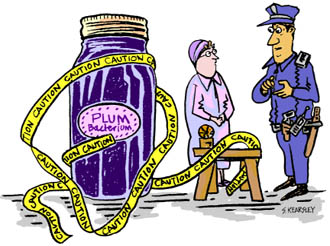 There's some happy anticipation as you unscrew the band, pry
loose the metal lid, and taste those incredible peaches you
canned last August! Equally, there's great pleasure in using
summer's flavorful tomatoes in the middle of November.
There's some happy anticipation as you unscrew the band, pry
loose the metal lid, and taste those incredible peaches you
canned last August! Equally, there's great pleasure in using
summer's flavorful tomatoes in the middle of November.
Indeed, canning is an old but simple process, one that both destroys microorganisms and seals jars, so the food inside keeps well beyond its fresh storage period.
How Home Canning Works
The most crucial part of canning is referred to as heat processing.
Here's how it works. Once jars are filled, the metal lids
and screw bands are applied, and the jars are placed in a
canner filled with water. As heating begins, the contents
of each jar expand, and changes in internal pressure take
place. Initially, gases are vented from the jar. When the
processing period is finished, the atmospheric pressure outside
the jar is greater than the pressure inside. This difference
in pressure pulls the lid down onto the jar and forms a vacuum
seal.
Heating for the required period of time also kills molds, yeasts, bacteria,
and enzymes that may be present. Your preserves now keep safely,
as the vacuum seal prevents microorganisms and air from re-entering
the jar and contaminating the contents.
No Short Cuts
Sometimes it's tempting to take shortcuts, but when canning it's not worth the risk. If spoilage microorganisms are not destroyed, canned goods are unsafe, and the consequences can be serious. Let's take a look at why some practices are now faulty or outdated.
Only Two Safety Approved Methods
All high-acid foods should be heat-processed in a boiling
water canner. This includes jams, jellies, preserves, marmalade,
fruit, pickles, relish, and tomatoes with added acid.
All low-acid foods must be processed at a temperature higher
than that of boiling water, i.e. in a pressure canner. Higher
temperatures are required to destroy naturally-occurring spores
that can cause botulism. Pressure canning must be done for
the designated time for the specific food and size of canning
jar. Low-acid foods include vegetables, tomato products with
added vegetables or meat, meat and game, soups, stews, seafood,
and poultry.
Potentially Unsafe Methods
Microwave canning, open-kettle methods or hot-fill, oven canning,
and steam canning are not considered safe. They do not create
or maintain the temperatures needed to vent jars or destroy
spoilage microorganisms.
New Lids Each Year
Don't reuse old lids. While it may look like there's enough sealing compound present on last year's metal lids, once the compound has been indented, it is unlikely to seal again safely. Screw bands can be reused.
Several older kinds of lids are no longer recommended because their failure
rate is high. Throw away zinc lids, old metal bands used with
rubber rings, and glass lids, or alternatively, store dried
foods in these jars. Outdated jars and lids can still be useful
for nonperishables, but not for canning.
New Information on Metal Lids and Screw Bands.
Read the package directions for preparing lids. They no longer require boiling. The new Snap lids, produced by Bernardin for instance, now only need heating in hot water (180 deg. F/82 deg. C) to soften the sealing compound so it sticks to the jar rim. Lids must be hot when placed on the hot jars. Screw bands need not be heated as they don't come in contact with food.
Apply screw bands securely until "fingertip tight" or just until there's some resistance. If they're too tight, air can't escape during processing and a vacuum doesn't form. Do not retighten bands or invert jars after processing. Both these practices can cause seal failure.
Just Any Jar Won't Do!
There are two good reasons why jars not designed for canning
cause trouble. Their seals fail more frequently because they
have a narrower sealing surface so it's less likely the lid
will cling tightly to the rim. Glass bottles break more frequently
than canning jars because the jars are not designed to undergo
the repeated changing temperatures of heat processing.
Your best bet is to use Mason jars, designed to take the heat and seal safely.
But even Mason jars won't last forever, so be prepared to
replace them when necessary.
The Bottom Line
As methods change, preserving companies strive to provide
the latest information on canning safety and supplies. But
consumers must update too! Use a reputable, up-to-date home
canning guide (often sold with canning supplies). It's always
better to be safe than sorry!
